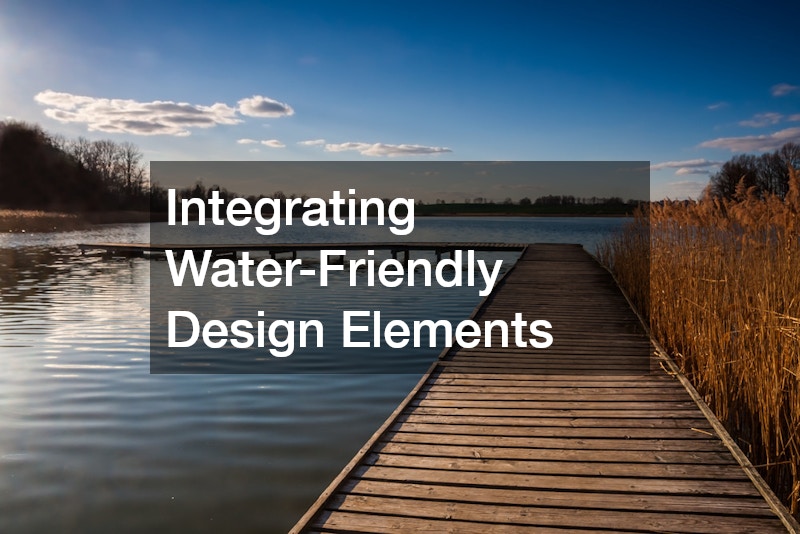

Designing a home by a lake offers unique opportunities that combine natural beauty with the calm of waterfront living. Lakefront properties provide stunning views, access to outdoor recreation, and a peaceful lifestyle that’s both visually inspiring and relaxing. However, creating a lakeside retreat that truly complements its environment requires thoughtful planning to optimize both aesthetics and function. For those living on a lake, designing a home involves balancing your personal style with the unique elements of lakeside living, such as sustainability, environmental concerns, and seasonal changes.
Understanding Lakefront Property Benefits
The Appeal of Scenic Views
One of the biggest perks of living on a lake is the access to stunning views right from your doorstep. The peaceful water and vibrant scenery create a landscape that evolves with the seasons, becoming an integral part of the home’s ambiance. To make the most of this, partnering with expert window contractors ensures you’ll have the perfect windows for uninterrupted, expansive views, bringing the outdoors inside while enhancing the architectural flow of the space.
Access to Recreational Activities
Having direct access to a lake opens up a world of recreational opportunities. Swimming, boating, kayaking, fishing, and paddleboarding are just a few of the activities available. Designing your home with easy access to the lakefront, like adding a well-placed dock or a cozy seating area near the shore, maximizes these recreational opportunities and makes lakeside living more enjoyable.
The Tranquility of Lakeside Living
Lakeside homes are a haven of calm, offering a natural sanctuary away from urban noise. With quiet surroundings and abundant wildlife, living on a lake invites you to slow down and enjoy nature’s pace. Thoughtful design choices that emphasize this peaceful atmosphere, like creating a quiet reading nook or designing with sound-absorbing materials, can amplify the sense of tranquility that lakefront living provides.
Increased Property Value
The demand for waterfront homes is consistently high, as many people are drawn to the allure of living on a lake. This often results in a notable increase in property value over time. Whether you’re looking at a new property for sale or planning to renovate your existing lakefront home, a well-designed lake house can be an excellent long-term investment.
Opportunities for Sustainable Living
Lakefront properties often provide unique opportunities for sustainable living. With access to natural resources and ample sunlight, homeowners can implement eco-friendly practices such as solar energy, rainwater harvesting, and sustainable landscaping. By designing with sustainability in mind, you can reduce your environmental impact while living comfortably on the lake.
Choosing the Right Architectural Style

Contemporary versus Traditional Design
Deciding between a contemporary or traditional design style depends on your aesthetic preferences and the character of the lake. Modern custom home builders often use clean lines, open floor plans, and large windows in contemporary homes to maximize views, while traditional designs might feature rustic woodwork and cozy interiors. Each style has its benefits, and finding the right balance ensures that the home feels connected to its natural setting.
Incorporating Natural Elements
A successful lakefront home embraces the natural surroundings, whether through material choice or architectural form. A timber frame house, for instance, is ideal for incorporating wood elements that create a sense of warmth and connection to nature. Exposed beams, natural stone, and reclaimed wood add an earthy touch to the design while enhancing the overall harmony of the lakeside setting.
Maximizing Window Use for Views
Windows are essential in a lakefront home, providing both natural light and scenic views. From expansive picture windows in the living room to skylights in the kitchen, well-placed windows capture the beauty of the lake at every angle. Consider working with window specialists who can customize the design to suit both the home’s architectural style and the lakefront’s particular views.
Building for Longevity and Durability
Lakeside homes endure the challenges of water, wind, and seasonal changes, so choosing durable, weather-resistant materials is crucial. Opting for materials like treated wood, composite decking, and rust-proof metals will extend the home’s lifespan and help minimize maintenance. Designing for durability ensures that the home remains beautiful and functional despite the demands of lakeside weather.
Balancing Aesthetics with Functionality
Achieving a balance between visual appeal and practical use is important for any home, especially one on the water. Thoughtfully blending aesthetics with functionality means choosing furniture, materials, and designs that are visually pleasing but also durable and practical for the lakefront environment. This balance ensures that your lakeside home is both stylish and resilient.
Designing with Environmental Considerations
Assessing Local Ecosystem Impact
When building a lakeside home, it’s essential to consider the impact on the local ecosystem. Lakes are delicate habitats that support diverse wildlife, so choosing environmentally friendly building practices and avoiding unnecessary disruptions to the land is key to protecting the natural surroundings.
Implementing Eco-Friendly Materials
Using eco-friendly materials like reclaimed wood, recycled steel, and non-toxic paints can reduce the home’s ecological footprint. These materials often blend seamlessly with natural settings, enhancing the home’s aesthetic appeal while promoting sustainability. By focusing on sustainable choices, homeowners can enjoy the beauty of living on a lake without compromising the health of the ecosystem.
Water Management and Flood Prevention
Proximity to a lake means that water management is a primary consideration. Implementing proper drainage systems, rain gardens, and permeable pavers helps prevent flooding and runoff issues. These practices protect both the home and the lake’s water quality, ensuring that the property remains safe from water-related issues.
Energy Efficiency in a Lakeside Home
Energy-efficient designs are both environmentally responsible and cost-effective. Incorporating energy-saving appliances, proper insulation, and energy-efficient windows can reduce the home’s energy consumption. By investing in renewable energy sources, such as solar panels or geothermal heating, lakeside homeowners can minimize their environmental impact and enjoy sustainable living on a lake.
Working with Local Geographical Challenges
Lakeside properties often come with unique geographical challenges, such as sloping land, uneven terrain, or wetlands. Collaborating with local professionals who understand these conditions can help in creating a home that respects the landscape while remaining resilient.
Creating Outdoor Spaces
Designing Relaxing Lakeside Decks
Outdoor spaces are a natural extension of any lakefront home. A well-designed deck with comfortable seating and beautiful views offers a perfect spot to relax and enjoy the lake. Choose materials like treated wood or composite decking that can withstand the elements while providing a safe, comfortable outdoor area.
Incorporating Outdoor Kitchens and Dining Areas
A lakeside kitchen or dining area can enhance outdoor entertaining options. Adding a built-in grill and durable outdoor furniture creates a functional space for gathering with family and friends. An appliance dealer specializing in outdoor kitchens can help find weather-resistant options that suit the lakeside environment.
Landscaping for Beauty and Privacy
Strategic landscaping adds beauty and privacy to a lakefront property. Native plants and shrubs can create natural borders that maintain privacy while blending with the landscape. For maintenance, consulting with a professional in lawn care will ensure the property remains both picturesque and sustainable.
Year-Round Outdoor Entertainment Areas
Creating a backyard that supports year-round enjoyment can make lakeside living more fulfilling. Incorporating fire pits, outdoor heaters, and shaded seating areas allows you to use outdoor spaces throughout the year, making lakeside living enjoyable even during the cooler months.
Integrating Water-Friendly Design Elements

Choosing Water-Resistant Materials
Using water-resistant materials for flooring, decking, and outdoor furniture is essential for lakeside homes. These materials withstand humidity and moisture, making them perfect for lakefront environments where weather exposure is higher.
Designing Easy Dock Access
Whether you enjoy boating, fishing, or just relaxing by the water, a well-designed dock enhances lakefront living. Integrating easy dock access with steps, railings, and slip-resistant materials ensures that the dock is safe and accessible.
Managing Water Runoff Effectively
Preventing water runoff from flowing directly into the lake helps maintain water quality. Adding a rain garden or using permeable pavers allows water to filter naturally, supporting both the health of the lake and the integrity of the property.
Enhancing Outdoor Views with Water Features
Incorporating small water features like fountains or ponds adds to the peaceful ambiance of a lakefront property. These features can be designed to complement the lake’s natural beauty, creating a cohesive and serene outdoor space.
Selecting Interior Design Ideas

Color Palettes That Reflect Nature
Using color palettes inspired by nature can enhance the lakeside aesthetic. Soft blues, greens, and earthy tones reflect the natural surroundings, creating a harmonious atmosphere. Adding contemporary art with nature themes can further connect the interior to the scenic outdoor environment.
Open Concept Living Spaces
An open-concept design with large windows creates an airy, light-filled home that emphasizes the connection to the outdoors. This layout also allows the lake views to be enjoyed from multiple rooms, enhancing the appeal of lakeside living.
Decorative Elements with Local Flair
Incorporating locally inspired decorative elements adds character and a sense of place to the home. From handcrafted furniture to regional artwork, local touches personalize the space, making it feel like a true lakefront retreat.
Furnishing for Comfort and Style
Opt for furnishings that are both stylish and comfortable, ideal for a relaxed lifestyle. Durable, easy-to-clean fabrics are a smart choice, especially for homes that host frequent gatherings. High-quality flooring installations that withstand wear and tear will also contribute to a stylish, long-lasting interior.
Understanding Local Regulations and Permits
Complying with Zoning Laws
Lakefront properties often have specific zoning laws that govern land use, so it’s essential to familiarize yourself with these requirements before beginning construction. Compliance with these laws helps avoid legal complications and ensures the property remains in harmony with the community.
Environmental Protection Protocols
To protect lake ecosystems, many regions have environmental protection protocols that limit shoreline alterations and mandate sustainable practices. Following these guidelines is crucial for preserving the beauty and health of the lake.
Dock and Watercraft Regulations
Dock size, placement, and watercraft use are often regulated to maintain safe and respectful lake use. Being aware of these regulations helps prevent conflicts with neighbors and ensures the lake remains a peaceful community space.
Building Code Compliance
Meeting all building codes, from foundation requirements to residential roofing materials, is essential for safety and legality. Following these codes will ensure that your lakefront home is built to standard and ready for the lakeside environment.
Property Lines and Riparian Rights
Understanding riparian rights and property boundaries is important when designing a lakefront home. These rights dictate access to and use of the shoreline, helping to prevent disputes and ensuring fair use of the water.
Managing Seasonal Changes

Winterizing Your Lakefront Home
Winter can be challenging for lakefront homes, so winterizing measures are essential. Insulating pipes, adding storm windows, and sealing gaps help keep the home warm and energy-efficient during colder months.
Summer Living Essentials
Summer months are prime time for lakeside living, so creating shaded areas, adding ventilation, and incorporating cooling elements like ceiling fans will ensure comfort in warmer weather.
Preparing for Storms and Flooding
Weatherproofing the home against heavy rains and storms is essential for lakeside properties. Ensuring the roof, siding, and foundation are well-sealed will protect the home from potential water damage.
Maximizing Natural Light and Ventilation
Design Techniques for Sunlight Optimization
Positioning the home to maximize sunlight reduces energy costs and enhances comfort. Clerestory windows, open floor plans, and reflective surfaces can increase natural light in the interior spaces.
Window Placement and Treatment Ideas
Strategic window placement brings in natural light and frames beautiful views. Treatments like light-filtering blinds allow you to control the brightness while maintaining privacy.
Incorporating Skylights
Skylights add light and warmth, particularly in rooms with fewer windows. Consulting with an electrician can ensure proper installation and integration with the home’s electrical system.
Utilizing Cross Ventilation for Cooling
Cross-ventilation keeps air moving throughout the home, naturally cooling it and maintaining fresh air quality. This design feature is both energy-efficient and practical for lakeside living.
Balancing Privacy with Openness
While lakefront views are a priority, maintaining privacy is also essential. Using landscaping or privacy screens can create secluded areas while still enjoying the openness of the lakefront.
Designing a lakefront home involves a thoughtful combination of aesthetic appeal, functionality, and environmental respect. By embracing the unique aspects of living on a lake, homeowners can create a serene retreat that complements the natural beauty around it. Through mindful planning and attention to sustainability, lakeside living becomes an enriching experience that harmonizes with the surrounding landscape.